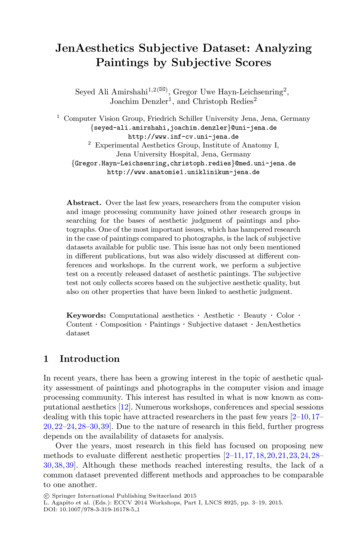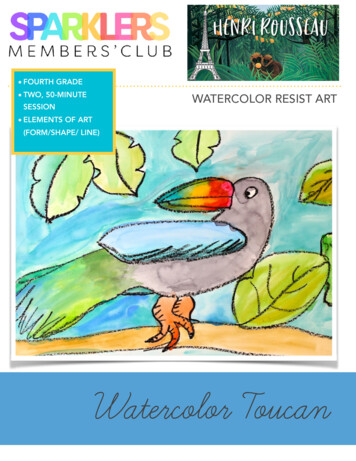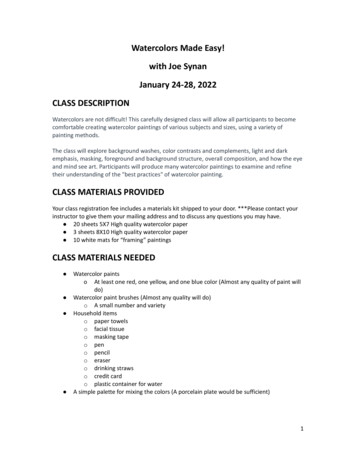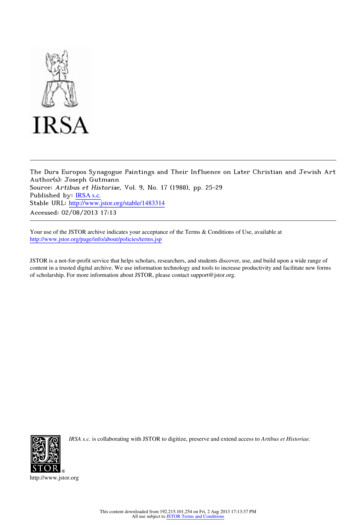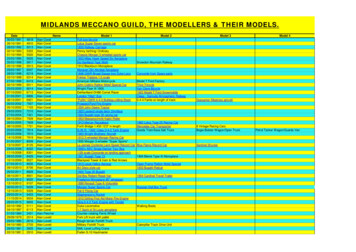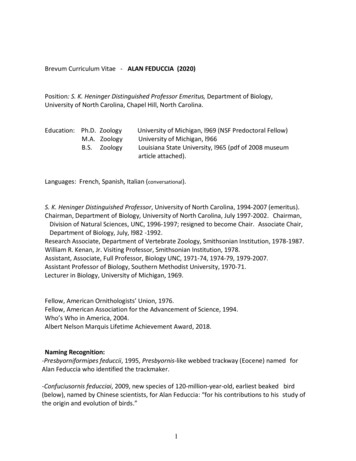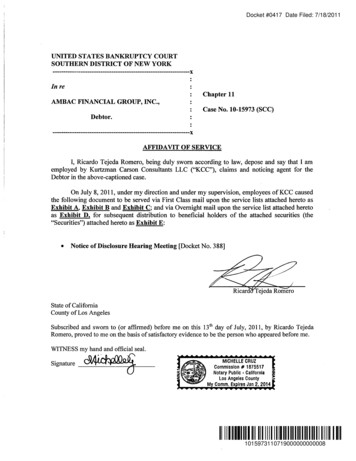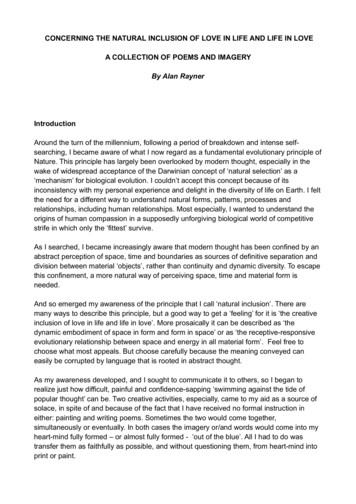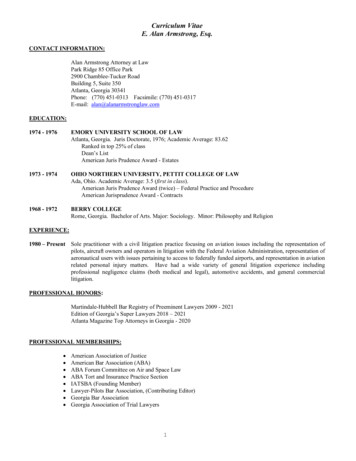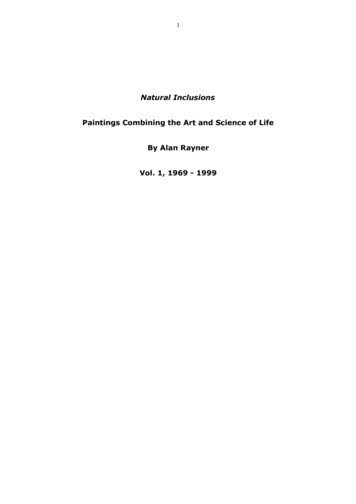
Transcription
1Natural InclusionsPaintings Combining the Art and Science of LifeBy Alan RaynerVol. 1, 1969 - 1999
2Preview‘Natural Inclusion’ is to my mind a fundamental principle of Nature.This principle provides us with a navigational aid, using our cavityat heart as compass, which helps us to recognise and avoid theproblems and falsehoods that arise from abstract perceptions thatestrange Nature from human nature. Moreover, by recognising ourbodily existence as an expression of, not an exception from naturalenergy flow, it enables us to discover ways in which we can livewiser, more loving, creative, sustainable and fulfilling lives. It is theevolutionary source of all the diversity of material form thatemerges in Nature through the receptive-responsive relationshipbetween space and flux – void stillness and energetic movement.To understand this principle requires a shift from the abstractperception of space, time and material boundaries as sources ofdefinitive separation between independent objects, to recognisingthem instead as mutually inclusive sources of natural continuity anddynamic distinction between flow-forms. In effect this represents ashift from rigidly static to fluidly dynamic framings of reality: fromabstract ‘freeze-framed geometry’ to natural ‘flow geometry’.Although I did not initially realise this, all my paintings made since1969 illustrate this shift in perception. They all depict imaginaryscenes, based on real experience and study of natural form, whichoften come into my mind ‘out of the blue’ rather than deliberateintent. They are sometimes accompanied by a poem. My role asartist is to allow these scenes to form in my mind and then toportray them to the best of my self-taught ability.
3“FIERY HORSE”Oil on Board, 1969An early experiment with oil paints, depicting my adolescent maleyearning for female care and guidance to soothe and direct myagitation.
4“FIERY SWAN”Oil on Board, 1970Made after an idyll by a sea loch in the west of Scotland, this marksa kind of breakthrough when I found a style of oil painting thatsuited what I wanted to express in spite of, or perhaps because of,my technical limitations. It was also the first time that the swanemerged, both in dreams and in paintings, as a symbol of serenewandering and fiery self-assertion.
5“BALLETIC TERN”Oil on Board, 1971A delicately counterpoised tern, balanced above a moonlit enclosureof sea, takes in with the spread of its beak, wings and tail,contrasting scenes of highland and lowland, dryness and wetness,darkness and light, framed by tangles of fuchsia, bramble andquaking grass.
6“TROPICAL INVOLVEMENT”Oil on Board, 1972This painting, made after my final examinations, depicts thedynamic complexity of living systems. A turbulent river rushesbetween rock-lined banks from fiery, tiger-striped sunset towardsunexpected tranquility where it allows a daffodil to emerge from itsshallows. A night-bird follows the stream past intricately interwovenforest towards darkness. A dragonfly luxuriates below a fruit-ladentree, bereft of leaves. Life is wild, wet and full of surprises.
7“ARID CONFRONTATION”Oil on Board, 1973This painting, made after a year of postgraduate research, depictsthe limitations of unempathic, analytical methodology. At the endof a long pilgrimage, access to life is barred from the objective stareby the rigidity of artificial boundaries. A sun composed of semicircleand triangles is caught between straight lines and weeps sundropsinto a canalized watercourse. Moonlight, transformed intopenetrating shafts of fear encroaches across the night sky above aplain of desolation. Life is withdrawn behind closed doors.
8“OUT OF THE SHADOWS”Oil on Board, 1973A golden eagle, symbolizing hope, emerges out of the shadows ofan austere rock face to fly out over sea towards sunlight.
9WILLOWY BRIDGE”Oil on Board, 1974A rowing boat is guided along a channel, too narrow to dip its oars,between opposing cliffs of abusive aggression and serene obstinacy,symbolized by hawks and swans. The way out into the sunlit oceanis through a curtain of leaves trailing from the hair of two willowyfemale figures who bridge across the chasm between sides that, atbase, are not so very unlike one another.
10“NIGHTFALL”Oil on Board, 1974A female figure draws a net curtain of stormy darkness across aglittering daytime scene, irradiated by sunny terns and with flowersreceptive to the wanderings of a butterfly and passing gannet.
11“FISHING IN HOPE”Oil on Board, 1975Painted at a dark, self doubting time (I was completing my PhD!),this depicts the feeling of hope and reassurance that I once felt asa child watching a party of Italian fishermen, fishing in still water bymeans of light and net.
12“BROADLAND”Oil on Board, 1976Painted after a holiday on the Norfolk Broads, this contains a ratherelaborate heron, a marsh harrier and a bridge to nowhere, reflectingthe relief of tension in that watery landscape.
13“PANDA”Oil on Board, c. 1984Painted for my younger daughter, Philippa, because she lovedPandas.
14“KOALA AND OWL”Oil on Board, c. 1984Painted for my older daughter, Hazel, because she loved Koalas andOwls.
15“SOLSBURY HILL”Oil on Board, c. 1990Painted for my daughter, Hazel, based on the scene she loved fromher bedroom window of the ancient hill fort of Solsbury Hill, anddrawing from the lines of the Peter Gabriel song about that hill, “aneagle flew out of the night”.
16“OTTER”Oil on Board, c. 1990Painted for my daughter, Philippa, because she loved otters. Thepainting includes some favourite themes of recession, waterdroplets and the self-repeating patterns of fern fronds.
17“IVY RIVER”Oil on Board, 1997An ivy river sweeps down from its collecting tributaries in steepsided, lobed valley systems in high mountains, through dark forestand out across a sunlit, starkly agri-cultured, flood plain. Thence itdelivers its watery harvest through deltas of leaves and fruits to asea filled with the reflection of sunset. The fruits and leaves of areal ivy plant fringe the view of the distant river. The erratic patternof veins in the lobed leaves contrasts with the focused pattern in theunlobed leaves and reflects the difference between the energygathering and energy-distributing parts of the river.
18“LOVING ERROR”Oil on Board, 1998This painting illustrates the dynamic interplay betweendifferentiation and integration, irregularity ("error") and regularity,and negative draining and positive outpouring that is embedded inliving system boundaries. The erratic fire in the venation of a lobedivy leaf is bathed in the integrating embrace of a heart-shaped leafwhich converts negative blue and mauve into positive scarlet andcrimson. The midrib of the heart-shaped leaf emerges as abindweed which communicates between extremes of coldness anddryness.
19“FOUNTAINS OF THE FOREST”Oil on Board, 1998This was painted for the British Mycological Society, in my year asits President, to depict the dynamic interrelationships of trees andfungi. Within and upon the branching, enfolding, water-containingsurfaces of forest trees and reaching out from there into air and soilare branching, enfolding, water-containing surfaces of finer scale,the mycelial networks of fungi. These networks provide acommunications interface for energy transfer from neighbour toneighbour, from living to dead and from dead to living. Theymaintain the forest in flux as they gather, conserve, explore for andrecycle supplies of chemical fuel originating from photosynthesis.So, the fountains of the forest trees are connected and tapped intoby the fountains of fungal networks in a moving circulation: anevolutionary spiral of differentiation and integration from pastthrough to unpredictable future; a water delivery from the fire ofthe sun, through the fire of respiration, and back again to sky,contained within the contextual boundaries of a wood-widecirculation.
20“OASHISS”Oil on Board, 1998Painted to depict the vitality and unpredictability of the partnershipbetween DNA and water, the informational traffic and the contextualwaterways, of living systems. A riverine snake, with DNA markings,guards a water-hole in a desert of sand particles blown into waves.Pebbles at the edge of the water, modelled on the “stone cells”(“sclereids”) that make pears gritty, are separate, yetinterconnected via their cores. A goat skull and a fish out of watershow the effect of exposure to dryness.How do we react to the snake? Do we attempt to control and predictits movements? Do we recoil from it? Do we relate ourselves to it?Which of these reactions promises most, or most threatens ourquality of life?
21“TROPICAL HEIGHTS AND DEPTHS”Oil on Board, 1998Painted for my friend, Rytas Vilgalys, following a meeting in PuertoRico where, on successive days, we explored first a coral reef andthen a rainforest, heralded by a blast blown through a conch shellby our navigator. The ascending, spiralling cavities of the conchshell refer to the venation pattern in the yam leaves, the climbingferns and the termite trails in the forest. Their boundaries containan underwater scene in which corals and sea fans relate to thearchitecture of trees, tree ferns and mosses in the forest, and fishreflect the descent of raindrops.
22“CONCH QUEST”Oil on Board, 1998Painted in the same vein as “Tropical heights and depths”, this wasfor me and my wife, Marion, as a reflection of our soulful questtogether to find meaning in the diversity and richness of lifepatterns.
23“INTERTIDAL HIGHLANDS”Oil on Board, 1998A standing wave of sugar kelp leads in from the ocean edge acrossmussel-bound rocks strewn with a chain of starfish. Brown, red andgreen algae, lichens and barnacles, limpets, sea anemones and dogwhelks array themselves in zones and cyclic progressions under theangry gaze of a red-eyed, lurid swimming crab who surveys hiskingdom from a bed of pepper dulse. Vulnerable brittle starsinsinuate their way towards shelter. Choughs ride the air waves.
24“ROLLER COASTER”Oil on Board, 1998A ferny-feathered blue roller, streaming upwards, transforms adusty brown study of books and analytical devices, precisely butincoherently arrayed out of perspective of table-top context, pastclaustrophobic, tar-spotted sycamore woodland, into an eternalquest for belonging. Bookshelves become rock strata whose caveshave protected ancient scrolls through ages riven by the pain ofconflicting aspirations. A sun, the magnification of hidden powderymildew fruit bodies on the underside of green-blotched leaves castsits beauty into the eye of the beholder.
25“IBOTENIC THREAD”Oil on Board, 1999This painting illustrates the significance of the fly agaric mushroom,Amanita muscaria, or, more specifically, ibotenic acid, thehallucinogenic compound that the mushroom contains, in humanculture. The scale-shifting properties of the mushroom, said to haveinspired Lewis Carroll’s Adventures of Alice in Wonderland, aredepicted as a spiralling red and white-spotted screw-thread (basedon the mushroom cap) around a telescopic staff (based on themushroom stem). The groove of the thread links a Heavenly skycontaining rain clouds formed from the spore-bearing “basidia” ofthe fungus to a Hellish inferno across an earthscape of mountains,forests, rivers, flood plains and sea. This thread symbolizes theShamanic use of the fungus, and the endless communion ofmasculine (linear) and female (curved) themes, to transcendoutermost and innermost realms of consciousness.
26“TORTUOUS ADVANCE”Oil on Canvas, 1999The moss, Tortula muralis, with twist-topped spore-producingcapsules and cushions of bristle-pointed leaves, advances across anexposed boundary of constraining brickwork built both to shelterand to confine human beings, towards a distant green hill. The hillcontains the self-same shape as the moss and is topped by a trinityof trees, two straight-trunked, the other forked, symbolizing thenatural communion of shadow and conscious selves.
27“VERNAL ILLUMINATIONS”Oil on Board, 1999Separate sexes of hazel and alder catkins, and hermaphroditeflowers of celandines, illuminate springtime emergence from winterdarkness. The impenetrable, mirror surface of a lake of clear tearwater contains both shadows and reflections but admits no insightwithin its straight-edged, arum-lined, and sinuous boundaries. Griefis fathomless, imponderable, but not without respite or hopecascading from the conciliation of polarities.
28“PLAIN BROTHERHOOD”Oil on Board, 1999Silver and gold strands of rain and sunlight are strung, harp-wise,from the sinewy, strong legs to bass clef wing plumes of a maleostrich with negligee of black belly feathers. Black-backed, pinkpalmed, male hands, modelled on my hands, emerge like primaryfeathers from white coverts and fiery secondary feathers in thewings of crowned cranes, mutually supporting each other’s onelegged stance. The hands stretch out to pluck the harp strings. Wetseason gives way to dry, across a sinuous path on which twowarriors stand one-legged, spear-supported to left or right, vigilantyet content and open-handed in the generosity of theirunconditional love. Swallowtail butterflies link darkness and lightfrom giraffes to zebras. Acacias transform stems to leaves. An eggcracks open, perpendicular to the hatching plane to reveal – what?This is where I came from.
29“RETICULATE CONCERTO”Oil on Board, 1999Painted for Tom, Barbara, Emme, Patty and Sam Bruns who visitedBath and England from Berkeley, California. Tom studies mycorrhizalfungi and evolutionary trees, and his e mail name is boletus. Thepainting picks up these themes and associates aspects of Bath andEngland with aspects of North America and California. A Boletusreticulatus fruit body, with organ-pipe tubes, Berkeley hillside capand Golden Gate Bridge over fog-strewn Bay, emerges out of aforest network tapped into by Indian pipe plants and broken into byfire and poison oak. Redwood columns emerge from the network,supporting a fan-vaulting of least parsimonious branches conjoinedby the Gorgon's Head of Sulis Minerva. Yosemite waterfall and oakmoss lichen cascade between the columns. Yosemite valleystretches into the distance, the deep blue sky given point by apassing turkey vulture. A real-life internet connection.
30“FRINGE FESTIVAL”Oil on Linen Canvas, 1999Patterns in Cladonia lichen, Marchantia liverwort and blue fescuegrass combine with rock and water to create an illusion of fireworks,ocean spray and bepalmed tropical island, overlooked by turretedlight and dark towers and surrounded by incoming wavelets andsandy shore bedecked with castles of child’s play.
31“I’M-MIGRATION”Oil on Canvas, 1999Implicit in the outward forms of migrant birds and animals aretravellers’ tales of flights and treks, of arrivals, departures and timein motion. The migrants bring with them a cultural heritage thatenriches the lives of residents. In its long journey, an EnglishSwallow, dark from above, light from below, swallows landscape. Itstravail begins in the elemental South African solar heat that istransformed by photosynthesis into Protea flowers. The heatgenerates a propelling force that carries the bird over veld, abovewater-seeking springboks, across deserted sand dunes and darklight realms of fluttering hoopoes until green-topped, white cliffssignal arrival time before May begins to bloom. Speedwell urgesonwards; forget-me-not reminds of home; cowslips reflect thestrengthening warmth of rising sun, and terns join in aerobaticarrival celebrations. But where is the welcome for humanimmigrants?
32“ARCHANGELIC CHANNELS”Oil on Canvas, 1999A hermaphrodite Yellow Archangel Flower, cut in half to exposereceptive channels of gynoecium and donating channels ofandroecium, flies and falls through universal space, creating andfollowing channels of least resistance bounded by cascading Aurora.
33“TRIPLE ENTENDRE”Oil on Board, 1999A lost, last, low speed train draws out of blackness towards opensky across a viaduct. The viaduct is supported by the cyperaceoustriangular cross-section of a stem of wood club-rush containing airand water-filled channels and framed by the left and right sides andhead-on symmetry of three emerald and yellow grasshoppers fusedby their antennae into a chaotic three-way attractor. The triangle iswedged between domains of grass and sedge, each with tripartiteflower arrays and inhabited by grasshopper and sedge warblers withtheir fishing reel and grating voices. The traverse of a harvestmouse conjoins the domains and so in its own small, sweet waymakes the whole interdependent, multidimensional scene possible,complete with sound and visual reverberations.
34“COUNTER-CURRENTS”Oil on Canvas, 1999A detached silver feather, blown by wind, and a fallen gold leaf web,caught in river currents, drift apart. But ducks, propelled by theirself-possession of both wing feathers and feet webs, take to both airand water as they choose and so, within shifting limits, make theirown ways. In these ways they create the fore and aft of a life-boatpattern, seen only from an imaginary perspective, that plies thesurface of yet greater, more mysterious depths. So too might airyintellect and watery emotion be related when life’s dynamic contextis fully filled.
35“OPENING ENDINGS”Oil on Canvas, 1999An elm tree’s demise, its wing-barked boundaries opened byravages of bark beetle and fungus, makes way for new life to fill itsspace. Maple leaves take over the canopy between earth and sky,but their coverage is only partial, leaving openings for arriving anddeparting flights of woodpeckers. Fungal decay softens the wood toallow the tunnelling of long-horn beetle larvae and probing andchiselling of beak-endings. A nest cavity provides a feeding stationbetween egg and air.
Paintings Combining the Art and Science of Life By Alan Rayner Vol. 1, 1969 - 1999 1. . Oil on Board, 1969 . dusty brown study of books and analytical devices, precisely but incoherently arrayed out of perspective of table-top context, past claustrophobic, tar-spotted sycamore woodland, into an eternal .
